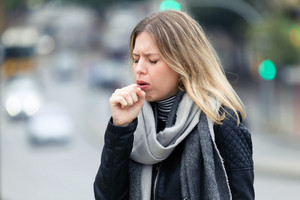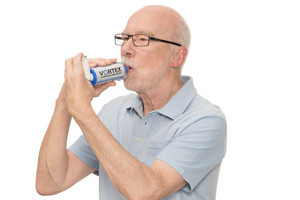Wednesday, 24. August 2022

The anti-inflammatory effect of cortisone sprays is essential for asthma patients. Regular and consistent spray inhalation is therefore very important. However, cortisone sprays can cause undesirable side effects.
The most common side effects of cortisone spray are:
You should take any type of side effect seriously – even if not listed here – and have your doctor check it out. Please read the package insert for information on all the side effects the spray you have been prescribed can cause.
The wrong inhalation technique can also make side effects more likely. Instead of reaching the bronchial tubes, the cortisone spray may end up in your mouth and throat where it can trigger the side effects described above. If this happens, the medication also will not have the desired effect, as too little actually reaches the bronchial tubes.
These easy tips can reduce side effects such as hoarseness, cough and oral fungal infections.

The most important tip is to use a holding chamber known as a spacer to inhale the spray. This helps prevent the medication ending up in your mouth or throat which is the main cause of the side effects mentioned above.
Inhalation with the spacer is easy and convenient. The spacer is attached to the spray. You then inhale using this upstream chamber. Check out all the benefits of spacer inhalation and instructions here.
If you have asthma, COPD or another respiratory disease for which you have to inhale bronchodilators or anti-inflammatory sprays, you can get a spacer or, for instance, the VORTEX® holding chamber. The spacer is available from the pharmacy and online.
Rinsing your mouth and gargling washes away any residues of medication from your mouth and throat. If you inhale using a holding chamber with a mask, you should wash your face thoroughly afterwards.

Most patients have to inhale their spray in the mornings and evenings. If you integrate your spray inhalation into your morning and evening routine and always inhale before you clean your teeth, you can kill two birds with one stone.
First, this ensures that your inhalation therapy is consistent and that you do not miss an inhalation. And secondly, you automatically follow-up the inhalation by cleaning your mouth and throat, which removes any drug residues.

Eating or drinking after the spray inhalation has the same effect as the methods mentioned above. It also reduces the residues of the medication in your mouth and throat.
Choose which tip is easiest to integrate into your daily routine.
Note: The information in this blog post is not a treatment recommendation. The needs of patients vary greatly from person to person. The treatment approaches presented should be viewed only as examples. PARI recommends that patients always consult with their physician or physiotherapist first.
An article written by the PARI BLOG editorial team.
© 2024 PARI GmbH Spezialisten für effektive Inhalation